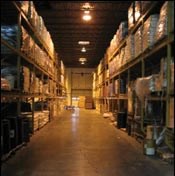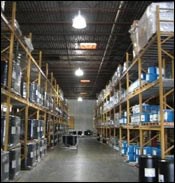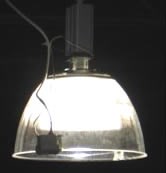Palm Goes Green
Lighting upgrade provides energy savings, other benefits
In the finishing industry, most engineers and managers think of energy savings in terms of lowering process temperatures or improving the efficiency of curing ovens.
But Palm Commodities International, LLC (PII; LaVergne, TN) took a bit of a different approach. As a result, the company, a supplier of metals, nickel sulfamate and other raw materials for plating chemistries, is saving money on its energy bills while gaining a tax break and experiencing improved worker productivity.
“The plating industry has been abuzz as nickel and other commodity prices have climbed higher and higher over the last couple of years,” says PII energy analyst Erik Daugherty. “But energy cost increases have focused attention on efficiency. We recognized this and invested in energy efficiency technology such as new lighting in offices, warehouses, and production facilities.”
According to Daugherty, lighting is the largest cost component of the electric bill in many commercial buildings and a significant portion of the total energy bill. “For years, energy-saving lighting solutions have been available that can reduce lighting energy costs while maintaining or potentially improving lighting quality,” he says. “The Energy Cost Savings Council (ECSC; Washington, DC) says energy-efficient lighting generates an average projected payback period of 2.2 years and a 45% return on investment. Energy-efficient lighting is becoming a common feature in new construction. Lighting is generally considered the easiest, most profitable investment in energy-saving building systems.”
In mid-2006, PII’s lighting systems were in need of an upgrade. Daugherty says the decision to switch to low-e lighting throughout PII’s plant, warehouse and office spaces has reduced the company’s energy costs by at least 40%. Payback periods on the projects range from eight months to less than three years in various areas of the facility.
Getting Started
Energy costs are often overlooked or viewed as just an unavoidable part of doing business. Daugherty says this approach might have worked in the past, when energy costs were relatively low, but electricity and natural gas prices are increasing and cannot be ignored.
“To start, PII assessed electrical and natural gas bills for the previous two years in order to evaluate the monthly and annual energy expenditures,” Daugherty explains. “Increasing electric bills were due to increasing electricity charges and expanded operations. Monthly bills of roughly $5,000 for the warehouse and office space are significant, especially when a dramatic reduction can be easily accomplished and provide a strong return on investment.”
PII managers understood that relatively simple upgrades to the lighting systems would provide a significant reduction in the company’s monthly electric bill. They also recognized that many old high-intensity discharge (HID) lights in PII’s warehouse—the common orange high-pressure sodium bulbs with magnetic ballasts, each of which consumed 465 W—were “out” and needed to be replaced, regardless. “After evaluating the cost of purchasing more of the same conventional, low-quality lighting, noting the significant monthly energy costs, recognizing the poor quality of the existing warehouse and production lighting and seeing examples of new fully electronic lighting technology, it became obvious that the old lighting system needed to be upgraded,” Daugherty says.
The warehouse upgrade proposed by electrical supply houses was installation of T8 or T5 fluorescent high-bay fixtures. “This is the type of fixture used in many large warehouse-type retail stores such as Home Depot,” Daugherty explains. “We identified several disadvantages to this type of warehouse fluorescent lighting: it required a higher number of fixtures with 4–6 lamps per fixture, and it did not allow a dimming function for energy savings.”
Instead, PII explored new, fully electronic fixtures with a “white” metal halide HID light and clear parabolic lens. “This type of fixture would produce more intense light per fixture and, combined with the clear parabolic lens, would allow us to actually decrease the number of fixtures in the warehouse,” Daugherty says.
Supplied by ROMlight International Inc., the new fixtures provide multiple benefits. “Each fixture operates on 335 W, and fewer of them are required,” Daugherty explains. “This greatly reduces maintenance and replacement lamp costs. And, occupancy sensors were also attached to dim and shut off fixtures during times of inactivity.”
According to Daugherty, ROMlight will soon release a state-of-the-art lighting system that promises even greater energy savings and control. The new lighting system allows wireless lighting control through a building’s existing regular electrical wires. “This capability will allow a manager to use a PC to control dimming and on/off functions, view wattage consumption in real time and monitor building temperature,” he says. “It even enables peak load shifting. This means that during periods of peak demand—usually during the middle of the summer—the utility company may pay the user to decrease energy consumption to avoid a ‘black-out.’” PII would have certainly installed such a system had it been available, he adds.
Hardware, installation and disposal of the old lamps cost a total of $31,365.14. Daugherty says annual savings in energy and maintenance costs total $12,553.34, an annual return on investment of just over 40%.
In addition, PII’s lighting contractor, Energy & Environment LLC (Atlanta, GA), used a spreadsheet calculator based on EPA values to provide some additional metrics that illustrate not only substantial energy savings but also the amount of greenhouse gas and other emissions avoided as a result of the project. These included equivalent units of carbon dioxide (greenhouse gas), sulfur dioxide and nitrogen oxides prevented; acres of trees planted; and number of cars removed from the streets and the amount of gasoline saved as a result of their removal. The numbers:
- Carbon dioxide saved (lb): 210,010
- Sulfur dioxide saved (g): 812,040
- Nitrogen oxides saved (g): 350,017
- Acres of trees planted: 41
- Number of cars removed: 20
-
Gasoline saved (gal): 12,728.
Office Upgrade
The decision to upgrade to energy-efficient lighting in PII’s 80,000 sq ft warehouse was relatively easy—many of the old fixtures needed to be replaced anyway. But Daugherty says the decision to upgrade the company’s old office lighting system was less cut and dried. “In most areas there was plenty of light,” he says. “But in reality there was too much light overhead in most areas, and some old lamps were about to go ‘out.’ After evaluating the potential energy-savings and productivity benefits, it became clear, once again, that the old lighting system needed to be upgraded.”
Once again, PII identified the type of new lighting technology necessary to provide proper light levels and decrease energy consumption. The company determined that most of the office lighting could be simply retrofitted and would not require more expensive total replacement.
According to Daugherty, they also looked at how modern office employees work. “The trend in today’s offices is to reduce overhead lighting to minimize computer glare and provide task lighting for computer work, writing, reading and other tasks,” he says. “This provides better lighting for each purpose and saves energy.”
Consisting of 16,000 sq ft of floor space on two floors, PII’s offices already had task lighting built into the cubicles; however, this was old technology that also had to be replaced. Many employees indicated they preferred less glare from overhead lighting and would benefit from improved cubicle task lighting that did not generate as much heat and did not hum like the old fluorescent fixtures.
Daugherty says there are several energy-saving office lighting options that can provide superior performance and savings versus existing overhead recessed lighting fixtures with magnetic T12 ballasts. These include fixtures with an electronic ballast with a low ballast factor of 0.77 and T8 28-W lamps. Regular incandescent light bulbs in the office can also be converted to compact fluorescent lamps (CFLs), he adds.
Through some research, PII recognized that the new lighting system could maintain sufficient light intensity with fewer lamps than the old system. “The old conventional lighting layout utilized four lamps per recessed office light,” Daugherty says. “The new layout only uses three and two lamps per fixture, depending on the desired light output.” Decreasing the energy used in the office lighting system also substantially decreases waste heat given off by the lighting system, reducing the extra energy required to keep the office space cool, he adds.
One unexpected difficulty was finding a lighting retrofit company that knew how to retrofit office lighting systems rather than simply replace them—not to mention one that was willing to source new lighting technology and try new lighting control systems. But a qualified vendor was eventually found for the work. The lighting retrofit company replaced all the old magnetic ballasts and lamps with new electronic low-e T8 ballasts and 28-W lamps.
Like the warehouse lighting project, the office lighting retrofit produced substantial savings. Total project cost, including hardware, installation and lamp disposal, was $7,952.99. PII now saves nearly 31,000 kW of electricity annually—enough to power three homes for a year—for annual energy savings of $3,140.54. Annual maintenance savings total $5,414.74, while HVAC savings of $628.11 bring total annual savings to $9,183.39.
“That’s an annual return on investment of more than 115%, for a simple payback in about 10 months,” Daugherty says. Numbers from the lighting contractor’s spreadsheet showed the project saved more than 46,000 lb of CO2, 179,000 g of SO2, and 77,000 g of nitrogen oxides—the equivalent of planting nine acres of trees or removing four cars from the road.
PII tracked monthly electric bills following implementation of all the lighting upgrades. “The company expected to save over $15,000 per year on energy alone, but in reality the monthly electrical bills are indicating an annual savings of $30,000,” Daugherty says. “This pleasant surprise results in a simple payback period of roughly 1.5 years.”
More Benefits
Reducing energy bills is great. The savings fall directly to a company’s bottom line, according to Daugherty. But, he adds, there are also other financial benefits. “Writing off the cost of a capital investment such as energy-efficient lighting is not new,” he says. “Under current law, the cost of energy-saving investments must be capitalized and depreciated or amortized over time.
“What is new is that building owners can now potentially write off the entire cost of a new, energy-efficient lighting system in the taxable year it is placed in service. Signed into law in 2005, the Commercial Buildings Tax Deduction provides an accelerated tax deduction. So, if a cost item associated with installing new lighting is normally depreciated and claimed over a period of years, it can now be claimed in a single tax year.”
Daugherty points out that the tax break is a deduction, not a credit. A credit is a direct dollar-for-dollar reduction of tax liability, while a tax deduction is a cost subtracted from adjusted gross income when calculating taxable income. Tax liability is therefore not reduced dollar for dollar, but in proportion to the taxpayer’s tax bracket. The deduction currently runs through the end of 2008, meaning that any lighting projects completed this year can be written off on 2008 taxes.
“Congress is currently discussing an energy bill, and at this point we really don’t know what’s going to be in it,” Daugherty says. “Some of these government programs are meant to jump-start the market, and once it’s started they don’t feel it’s necessary to continue to provide those incentives.”
“The lighting-only accelerated tax deduction is based on achieving lower lighting power densities than the minimum required by commercial building standards in the U.S.,” Daugherty explains. “The deduction can enhance the financial attractiveness of investment in the most energy-efficient lighting technologies. Building owners can reduce operating costs and increase profitability and competitiveness by investing in the highest levels of energy-efficient lighting, and gain the added benefit of deducting up to the entire expense of new interior lighting in a single tax year.”
Given all the benefits PII is experiencing, Daugherty is amazed that the vast majority of commercial buildings in the U.S. continue to operate with old-style lighting. “According to the U.S. Department of Energy 80% continue to operate with lighting systems installed before 1986,” he says. “The reason typically given for not upgrading lighting technology is the initial cost. Energy-efficient lighting typically costs no more than 15 percent more to purchase than standard lighting and does not require any different labor for installation, but it can offer significantly lower operating costs resulting in profitable cash flow via avoided costs.”
Geothermal Option
PII also required a HVAC system upgrade, and the company explored possible installation of a geothermal system before eventually installing a new conventional system.
Geothermal energy works by tapping into the constant year-round temperature of about 50°F that is found underground. Water is pumped through high-density polyethylene (HDPE) pipes that are buried underground, and recirculated into the building using heat-pumps. In the summer, the liquid moves heat from the building into the ground. In the winter, it does the opposite, providing pre-warmed water to the heat-pump system of the building.
According to Daugherty, the company’s location near Nashville, TN is squarely in a geographic band that runs across the U.S. where heating and cooling requirements are nearly equal—an ideal situation to take advantage of geothermal heating and cooling. “Systems will work in the deep south, where you have primarily a cooling load, or in cooler climates where buildings require more heating,” he says. “But anywhere you have a lot of cooling needs in the summer and a lot of heating needs in the winter is a good location for a geothermal installation.”
Another incentive for PII to evaluate a geothermal system was assistance from the Tennessee Valley Authority (TVA). “TVA came out and drilled a 300-ft sample geothermal well and tested it to make sure a system was feasible for us,” he says. “I would suspect that other such programs are available in regions around the country.”
PII moved forward with proposals for both conventional and geothermal HVAC systems. According to Daugherty, a geothermal system would have cost about 70% more than a conventional system up-front. “The additional cost arose from the necessity to drill a vertical bore field,” he explains. “However, if a business has plenty of land with enough soil, it is much cheaper to install a horizontal trench system about 5 ft deep. “PII is located on solid rock, so we were limited to the more expensive vertical bore field option.”
Daugherty says the projected payback period for the project was a reasonable 6–7 years. “That was assuming current energy costs,” he says. “Of course, the payback would be shorter as energy costs increase.”
PII ended-up not installing the geothermal system in part because the existing infrastructure of the old HVAC system could more easily be married to a new conventional system. Geothermal systems are easier to install on new building sites where the bore field can be sited under parking lots.
Related Content
Professional Plating Expands Zinc, Ecoat Offerings
Ever expanding, Professional Plating of Brillion, Wisc., has announced two capital investments: a second zinc line and an upgrade of its ecoat capabilities.
Read MoreTTX’s Automated Conveyor Carrier System Offers Wireless, Flexible Operation
ACC system designed for reliable, consistent point-to-point movement of everything from small to heavy parts.
Read MoreAn Altruistic Growth Strategy Puts People First
Professional Plating emphasizes investing in its team and fostering a supportive environment on the shop floor.
Read MoreECOAT24 Attracts Both Serious Electrocoaters and Novices Alike
The conference, held April 2-4, 2024, in Orlando, Florida, provides the ecoating industry with educational sessions, supplier exhibits and networking with colleagues.
Read MoreRead Next
A ‘Clean’ Agenda Offers Unique Presentations in Chicago
The 2024 Parts Cleaning Conference, co-located with the International Manufacturing Technology Show, includes presentations by several speakers who are new to the conference and topics that have not been covered in past editions of this event.
Read MoreEducation Bringing Cleaning to Machining
Debuting new speakers and cleaning technology content during this half-day workshop co-located with IMTS 2024.
Read MoreDelivering Increased Benefits to Greenhouse Films
Baystar's Borstar technology is helping customers deliver better, more reliable production methods to greenhouse agriculture.
Read More
















.jpg;maxWidth=300;quality=90)









